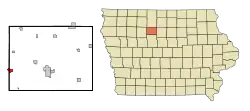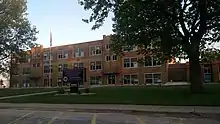Gilmore City, Iowa
Gilmore City is a city in Humboldt and Pocahontas counties in the U.S. state of Iowa. The population was 487 at the time of the 2020 census.[3]
Gilmore City, Iowa | |
|---|---|
| Motto: "Iowa's Limestone Capital"[1] | |
 Location of Gilmore City, Iowa | |
| Coordinates: 42°43′50″N 94°26′33″W | |
| Country | |
| State | |
| Counties | Humboldt, Pocahontas |
| Area | |
| • Total | 1.24 sq mi (3.21 km2) |
| • Land | 1.24 sq mi (3.21 km2) |
| • Water | 0.00 sq mi (0.00 km2) |
| Elevation | 1,224 ft (373 m) |
| Population (2020) | |
| • Total | 487 |
| • Density | 393.06/sq mi (151.76/km2) |
| Time zone | UTC-6 (Central (CST)) |
| • Summer (DST) | UTC-5 (CDT) |
| ZIP code | 50541 |
| Area code | 515 |
| FIPS code | 19-30945 |
| GNIS feature ID | 0456906 |
| Website | Official website of Gilmore City, Iowa |
History
Gilmore City was platted in 1884, not long after the railroad had been built through that territory in 1882.[4]
Gilmore City was originally known as Blooming Prairie. The name was changed to Gilmore City in the early 1880s. The city was named for Charles N. Gilmore. Gilmore was the superintendent of the Fort Dodge & Des Moines rail line and later became division superintendent after the road was leased by the Rock Island Railway Company. Gilmore died in Des Moines on April 5, 1912. The community was incorporated on April 16, 1887.[5]
Two quarries known as the Midwest Limestone Quarry and the Hallett Quarry were opened north of Gilmore City. Quicklime and dimension stone production began at least as early as 1882, and was succeeded by cement and aggregate production.[6] Fossil crinoids were discovered in the quarries 1929.[7] The Midwest Limestone Quarry is currently known as the Moore Quarry, owned by Martin Marietta Inc.[8]
Geography
Gilmore City is located at 42°43′50″N 94°26′33″W (42.730521, -94.442434).[9]
According to the United States Census Bureau, the city has a total area of 1.25 square miles (3.24 km2), all land.[10] It contains one neighborhood, Stein's Rockin R Mobile Home Park, Iowa, on the Pocahontas side of town.[11]
Gilmore City lies along the northeastern margin (rim) of Manson crater, an impact structure buried by glacial till and outwash.[12]
Demographics
| Year | Pop. | ±% |
|---|---|---|
| 1900 | 687 | — |
| 1910 | 689 | +0.3% |
| 1920 | 919 | +33.4% |
| 1930 | 896 | −2.5% |
| 1940 | 908 | +1.3% |
| 1950 | 746 | −17.8% |
| 1960 | 688 | −7.8% |
| 1970 | 766 | +11.3% |
| 1980 | 626 | −18.3% |
| 1990 | 560 | −10.5% |
| 2000 | 556 | −0.7% |
| 2010 | 504 | −9.4% |
| 2020 | 487 | −3.4% |
| Source:"U.S. Census website". United States Census Bureau. Retrieved March 28, 2020. and Iowa Data Center Source: | ||

2010 census
As of the census[14] of 2010, there were 504 people, 239 households, and 136 families residing in the city. The population density was 403.2 inhabitants per square mile (155.7/km2). There were 277 housing units at an average density of 221.6 per square mile (85.6/km2). The racial makeup of the city was 97.8% White, 0.4% African American, 0.4% Asian, 0.4% from other races, and 1.0% from two or more races. Hispanic or Latino of any race were 1.6% of the population.
There were 239 households, of which 25.5% had children under the age of 18 living with them, 43.5% were married couples living together, 10.0% had a female householder with no husband present, 3.3% had a male householder with no wife present, and 43.1% were non-families. 38.5% of all households were made up of individuals, and 15.1% had someone living alone who was 65 years of age or older. The average household size was 2.11 and the average family size was 2.80.
The median age in the city was 45 years. 22.6% of residents were under the age of 18; 6.7% were between the ages of 18 and 24; 20.9% were from 25 to 44; 30.9% were from 45 to 64; and 19% were 65 years of age or older. The gender makeup of the city was 48.2% male and 51.8% female.
2000 census
As of the census[15] of 2000, there were 556 people, 257 households, and 160 families residing in the city. The population density was 448.5 inhabitants per square mile (173.2/km2). There were 272 housing units at an average density of 219.4 per square mile (84.7/km2). The racial makeup of the city was 98.38% White, 0.18% Asian, 0.90% from other races, and 0.54% from two or more races. Hispanic or Latino of any race were 1.08% of the population.
There were 257 households, out of which 25.7% had children under the age of 18 living with them, 49.0% were married couples living together, 8.6% had a female householder with no husband present, and 37.7% were non-families. 35.8% of all households were made up of individuals, and 20.2% had someone living alone who was 65 years of age or older. The average household size was 2.16 and the average family size was 2.75.
22.1% are under the age of 18, 7.0% from 18 to 24, 23.0% from 25 to 44, 25.0% from 45 to 64, and 22.8% who were 65 years of age or older. The median age was 44 years. For every 100 females, there were 91.7 males. For every 100 females age 18 and over, there were 90.7 males.
The median income for a household in the city was $31,827, and the median income for a family was $40,208. Males had a median income of $26,176 versus $21,389 for females. The per capita income for the city was $15,511. About 3.8% of families and 7.9% of the population were below the poverty line, including 5.4% of those under age 18 and 13.6% of those age 65 or over.
Education

It is within the Gilmore City–Bradgate Community School District.[16]
Gilmore City has an elementary school with grade levels prep-kindergarten through the sixth grade. After the 2010–11 school year ended, the Gilmore City–Bradgate district created a joint agreement with the West Bend–Mallard Community School District. This moved all the students from seventh through twelfth grade to the West Bend–Mallard Middle School/High School which is located in West Bend.[17]
References
- "Official Website of Gilmore City, Iowa". Official Website of Gilmore City, Iowa. Retrieved August 31, 2012.
- "2020 U.S. Gazetteer Files". United States Census Bureau. Retrieved March 16, 2022.
- "2020 Census State Redistricting Data". census.gov. United states Census Bureau. Retrieved August 12, 2021.
- Flickinger, Robert Elliott (1904). The Pioneer History of Pocahontas County, Iowa. G. Sanborn. pp. 623–624.
- "Gilmore City, Iowa". City-Data.com. Retrieved August 30, 2012.
- An Excursion to the Historic Gilmore City Quarries by Frederick J. Woodson, Geological Society of Iowa publication, Guidebook 50, April 29, 1989.
- Laudon, L. R., 1933. The stratigraphy and paleontology of the Gilmore City Formation of Iowa. University of Iowa, Studies in Natural History, v. 15, no. 2, 74 p.
- Moore Quarry, Martin Marietta website, accessed 8 November 2021.
- "US Gazetteer files: 2010, 2000, and 1990". United States Census Bureau. February 12, 2011. Retrieved April 23, 2011.
- "US Gazetteer files 2010". United States Census Bureau. Archived from the original on January 25, 2012. Retrieved May 11, 2012.
- "Stein's Rockin R Mobile Home Park, Iowa". Geographic Names Information System. United States Geological Survey, United States Department of the Interior.
- Hartung, J. B., Kunk, M.J. and Anderson, R.R., Geology, geophysics, and geochronology of the Manson impact structure. Global Catastrophes in Earth History, Geological Society of America, Special Paper 247, pp. 207-221. 1990.
- "Census of Population and Housing". Census.gov. Retrieved June 4, 2015.
- "U.S. Census website". United States Census Bureau. Retrieved May 11, 2012.
- "U.S. Census website". United States Census Bureau. Retrieved January 31, 2008.
- "Gilmore City-Bradgate" (PDF). Iowa Department of Education. Retrieved March 27, 2020.
- Gilmore City-Bradgate Community School District. Gilmore City–Bradgate Community School District. Retrieved August 2013.